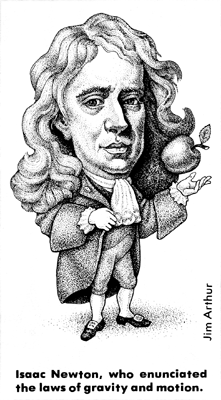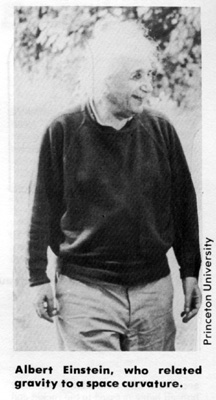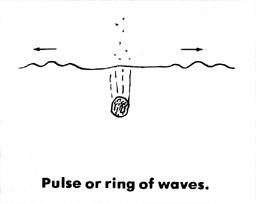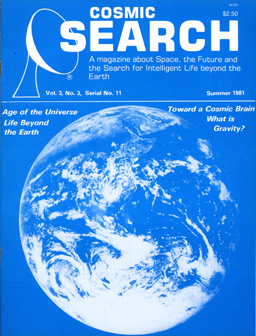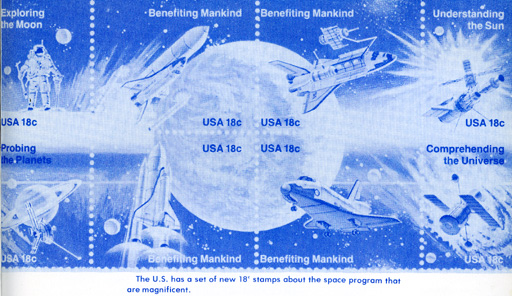![[NAAPO Logo]](../../Images/NAAPOsm.jpg)
North American AstroPhysical Observatory (NAAPO)
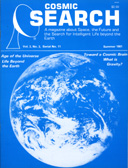
Cosmic Search: Issue 11
(Volume 3 Number 3; Summer (July, Aug. Sept.) 1981)
[All Articles & Miscellaneous Items]
|
Webpage Table of Contents (Bookmarks)
(Internal links to items in this webpage)
[Note. Use Back button (or <Alt>+<Left Arrow>) to get back to this Table of Contents after you have clicked on a link and viewed the article.]
Codes Used Below:
P: Starting page of article in magazine; A: Author(s); T: Title of article
|
The Age of the Universe — An Interview with William A. Fowler
By: Robert H. Van Horn
The following interview was done originally for broadcast over Public Radio Station WOSU in May, 1980 by Robert H. Van Horn, Science Reporter for WOSU and Contributing Editor of Cosmic Search. It is reproduced here with WOSU's permission. WOSU is operated by the Telecommunications Center of The Ohio State University. Dr. Fowler had delivered the annual Alpheus W. Smith Lecture in Physics at the University on the subject, "The Age of the Universe."
 Cosmic Search: Dr. Fowler, how old is the Universe?
Cosmic Search: Dr. Fowler, how old is the Universe?
Fowler: In my view, the Universe is twelve billions years old. Although that duration of time is almost incomprehensible in terms of human experience, we can claim that the uncentainty only falls in the range of ten to fifteen billion years.
C.S.: This is your own estimate. How did you make it?
Fowler: Traditionally, the age has been derived from the redshift measurements which were first perfected by Edwin Hubble and showed that we live in an expanding universe. When Hubble looked at distant galaxies, he found that they were receding with velocities that were proportional to distance. This velocity redshifted their light, and in that way he was able to measure their velocities. Also, by various schemes he was able to estimate their distances. If you know the distances and the velocities, you can estimate how long it has been since the galaxies were much closer together right after the Big Bang back in the beginning of the expanding universe.
C.S.: That seems relatively straight-forward.
Fowler: Those measurements are very sophisticated and very beautiful, but in spite of that, there are considerable uncertainities. Although the age of the Universe as derived from the redshift measurements is consistent with the twelve billion years which I believe to be correct, the uncertainty spreads all the way from seven billion years to twenty.
C.S.: These numbers then are not really measurements of age, but estimates?
Fowler: Well, of course, the redshift gives the velocity quite directly and very precisely if you believe it is a cosmological red shift as most of us do. It is named for the Austrian physicist, Christian Johann Doppler (1803-1853) who found the shift in the wavelength or frequency of sound from sources moving relative to the listener. It is also known as the Doppler Shift. The real trouble is that you can't pace off the distance to a galaxy, and astronomers, following Hubble and his contemporaries, have developed many clever indirect ways of determining the distance to a galaxy. It starts with parallax measurements on nearby stars, but eventually it all boils down to establishing certain types of galaxies as "standard candles." All of these standard galaxies have the same power output. The uncertainty is in the distance scale. That translated directly into the time scale using the redshift determination of the velocities.
C.S.: As I understand it, your measurement of the age of the universe is by a different method.
Fowler: Yes. I'm a nuclear physicist, so early in the game when my colleagues, Fred Hoyle and Geoffrey and Margaret Burbridge and I, came up with the general idea of the synthesis of heavy elements, including the radioactive ones, in stars, we realized we had a way of using nuclear radioactivity in cosmochronology, just as a geologist uses the radioactive elements to determine the age of a rock. In dating the time of formation of a rock, a geologist may have reason to believe that the rock had no lead in it when it was formed, but did have thorium which is radioactive and which decays to an isotope of lead. If he looks now at how much lead is in the rock, he can tell when that rock became a closed system.
C.S.: In other words, the geologist used radioactive decay of the elements as a geological clock.
Fowler: Yes Cosmo-chronology works much the same way, but with additional complications. Over the history of our Galaxy, we think that stars have been producing the heavy elements which some 4.6 billion years ago condensed out of the interstellar medium into the solar system. We are interested in understanding the relative amounts of thorium and uranium and the other radioactive elements so that we can use these nuclear chronometers in a manner similar to using an hour glass. I often refer to these nuclear chronometers as "eon-glasses," since they measure eons rather than hours. By studying the problem for some twenty years now, Barbara Zimmerman, my present colleague, and I have finally refined it to where we believe that the best estimate is twelve billion years, and that it cannot be much less than ten nor more than fifteen. Other methods are consistent with this, but being a nuclear physicist, I believe that the nuclear chronology gives the most accurate determination.
C.S.: Part of your work which led to this, as you just mentioned, was your development of the understanding of the synthesis of the heavier elements in the stars.
Fowler: Yes. As I noted previously, this work was done along with Fred Hoyle and Geoffrey and Margaret Burbridge. Geoffrey is now director of Kitt Peak National Observatory and Margaret is Professor of Astronomy at the University of California at San Diego and president-elect of the American Association for the Advancement of Science. Fred has retired as the Plumian Professor at Cambridge and lives in the Lake District of England. Most cosmologists now believe in the Big Bang as the start of the expanding universe. Nuclear physics tells us that the heaviest element produced in the Big Bang was helium. There was lots of hydrogen, and some helium, but no heavy elements except perhaps a trace of lithium; no carbon, no lead, and in particular no uranium and thorium.
C.S.: I see.
Fowler: We have known for almost the whole of this century that stars probably shine on nuclear energy. When they shine on nuclear energy, they convert one form of nuclear matter into another. The sun in [sic; "in" should be "is"] shining on the conversion of hydrogen into helium. When the sun becomes what astronomers call a red giant star, it will shine for a while on the conversion of helium into carbon. So the very process by which stars give off energy transforms lighter elements into heavier
ones. To make a long story short, we worked out processes, — a number of them, and they are not simple — processes which take place during the lifetime of stars which can eventually build all the way up to the heaviest elements like uranium and thorium, and all the ones in between.
C.S.: That's a very impressive structure.
Fowler: I think it's fair to say in general that the astronomical observations and experiments in nuclear laboratories — although they have modified the picture and I think that's great — have led in the main to the acceptance of this point of view of the synthesis of the elements.
C.S.: It strikes me as you describe these processes, and in particular your eon glass concept, you had to have an eon glass full of thorium to start with to get your time scale started. But there was no thorium at the time of the Big Bang. There must have been an interval before you had the thorium to fill your eon glass.
Fowler: Oh yes. We have to take that into account. The contents of the eon glass we're talking about is the interstellar medium, the gas and dust in between the stars on our Galaxy. When a star is formed, it is formed with an abundance of thorium and uranium characteristic of the interstellar medium in the Galaxy at that time. Since we know that the solar system is 4.6 billion years old, we are interested in what was in the interstellar medium 4.6 billions years ago. Since the time when the solar system condensed out of that medium, it has been a closed system. No new elements have been put in, no new thorium and no new uranium.
C.S.: This 4.6 billions years is a lot less than the twelve billion years which you assign as the age of the universe.
Fowler: Yes, and I want to emphasize what that 4.6 billion years means, compared to the twelve billion years which is the age of the universe. I must also emphasize that we think all galaxies were formed very soon after the Big Bang, so our Galaxy is approximately twelve billions years old. We have independent ways of measuring the age of the oldest stars in the Galaxy, and their age is indeed about twelve billion years. So, you see, our Sun, our Solar System, is a late comer. The Galaxy started twelve billion years ago, and before the Sun formed, there were 7.4 billion years which involved the birth, evolution and death of stars. When a star dies, it sometimes ejects matter into the interstellar medium. The star explodes; the most spectacular examples are what astronomers call supernovas. They eject material back into the interstellar medium, but that material is enriched in nuclear debris. The ashes of the nuclear fires which fueled the star while it was shining produced heavy elements in the star which are ejected into the interstellar medium. When a new star forms as our Sun did 4.6 billion years ago, it inherits, for example, thorium which had been made by earlier stars which were born soon after the formation of the Galaxy and on up to the time when the solar system was formed.
C.S.: Now that we have filled in the geneology of the elements and the solar system, I wonder what you see as the next big steps for astronomy?
Fowler: To that question, you'll get an answer that depends on the person of whom you ask it. I'm still interested in the question of how the heavy elements are produced, and in particular, what can astronomical observations tell us about the sites, the places where nuclear synthesis occurs. We think supernovas in which a star suddenly explodes are such sites. The Crab Nebula is an example. If you look in the direction of Taurus you can see a nebulous region, and if you look with a high powered telescope, you can see tangled filaments of gas moving outward. We know that Oriental astronomers saw a new star in that region of the sky in the year 1054 A.D. which they called a "guest star," which I think is a delightful term. That was the explosion. The star had been too faint for them to see previously, but when it exploded and became a supernova, they could see it. The expanding material became the Crab Nebula. When we look at the Crab Nebula now, we find that there's a pulsar in the center of it. There is a stellar object there that is flashing on and off. We think it is a rotating neutron star. It's like a giant light house. The star produces a rotating beam. If you look one instant you see the beam. Then it is gone. One thirtieth of a second later it has returned. So you see a "pulsing" beam. It's really more like a light house beam and pulsar is a bit of a misnomer. We think what happened in this case was that the central region of the star collapsed. The collapse gave up a great deal of gravitational energy which was transferred in a shock wave to the outer part and blew the outer parts off.
Just now you asked me what has this got to do with the new astronomy. These objects are not only giving off radio emission and optical emission. They are also giving off X-rays and we think they are giving off gamma rays. In fact we know that the Crab Nebula is giving off gamma rays. The only way you can study X-rays and gamma rays is to get above the Earth's atmosphere. I think some of the big steps in astronomy are going to be the studies of these objects that made the stuff that you and I are made of, by looking at them with satellites that have big X-ray telescopes and gamma ray telescopes.
C.S.: What does this mean in the way of opportunities for young astronomers? Do the problems in funding for this sort of work put a limit on these opportunities?
Fowler: Of course, that is a problem. There's no question that federal space program funding has been going down in recent years. That means there are fewer opportunities for young people to come into astronomy. The funding of ground based astronomy has not increased in proportion with inflation. But my one answer to that is, "You don't go into astronomy for the money."
There are many dedicated young astronomers, and they are going to make do somehow.
C.S.: I'm glad to hear you say that.
Fowler: You don't have to emphasize the direct technological spin-offs from astronomy or the space program which I think have changed life for all of us. Astronomy makes a great contribution to human knowledge and culture. We're all interested in the stars. We're all interested now [sic; was "now" intended to be "not"?] only in the history of the human race, but the history of the earth, the history of the Sun, the history of the Galaxy, the history of the Universe, so I can't believe that there isn't going to be support for this marvellous science of astronomy. I'm also perfectly willing to admit and I think everyone in physics and astronomy has to realize that when times are tough, we all have to share some of the lumps with the rest of society. We can't go on doing things as usual. We've got to take some of the cut backs. We must spend some time on socially valuable applications. But we can also expect continued support of the basic sciences, and I think it is pretty clear that there are payoffs there, technologically from the spin-offs, and culturally from the gains in new knowledge about the world around us.
C.S.: Thank you, Dr. Fowler, for these very thoughtful insights.
 William A. Fowler is Institute Professor of physics at the California Institute of Technology. Born in Pittsburgh in 1911, he received a Bachelor's degree in Engineering-Physics from the Ohio State University in 1933 and a Doctor's degree from the California Institute of Technology (CIT) in 1936. Dr. Fowler has been on the staff of CIT since that time with several leaves as lecturer at Cambridge University, England. He has served as a member of the Science Board of the National Science Foundation, the Space Science Board of the National Academy of Sciences and the Space Program Advisory Council of NASA. Dr. Fowler has received numerous awards and medals including an honorary Doctor of Science degree and the Lamme Medal from the Ohio State University, the Bernard Medal from Columbia University, the Apollo Achievement Award from NASA, and the National Medal of Science.
William A. Fowler is Institute Professor of physics at the California Institute of Technology. Born in Pittsburgh in 1911, he received a Bachelor's degree in Engineering-Physics from the Ohio State University in 1933 and a Doctor's degree from the California Institute of Technology (CIT) in 1936. Dr. Fowler has been on the staff of CIT since that time with several leaves as lecturer at Cambridge University, England. He has served as a member of the Science Board of the National Science Foundation, the Space Science Board of the National Academy of Sciences and the Space Program Advisory Council of NASA. Dr. Fowler has received numerous awards and medals including an honorary Doctor of Science degree and the Lamme Medal from the Ohio State University, the Bernard Medal from Columbia University, the Apollo Achievement Award from NASA, and the National Medal of Science.
Dr. Fowler has published numerous articles on nuclear forces, nuclear spectroscopy and nuclear structure. In particular he has pioneered in studies of energy production in stars and how elements are formed in them, collaborating in this work with Margaret and Geoffrey Burbridge and Fred Hoyle. Their hypothesis that all elements might be produced in stars brought additional nuclear processes into recognition leading to explanations of how heavy elements have been built up through enrichment by stars of the interstellar medium and the formation of successive generations of stars.
|
|
Toward the Cosmic Brain
By: Don Lago
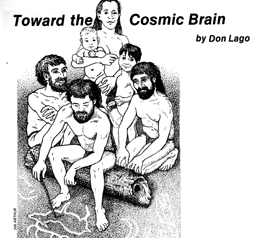
Many thousands of years ago, in a scene that must have been repeated many times in human history, a man quietly resting on a log grasped a stick and began scratching in the sand at his feet. He slowly moved the stick back and forth, carefully guiding it through curves and straight lines. Then he lifted the stick aside. He gazed upon what he had made, and a gentle satisfaction lighted his face. After a few moments his foot reached out to stir the sand, erasing the marks he had made upon it. Again he moved his stick over the sand and again he erased his markings and made new ones. Other people were resting nearby, and as they noticed what he was doing, a few of them gathered around to watch. Each time the man finished a drawing, the smile that appeared on his face would appear on theirs also.
This game of making images of familiar things held a strange fascination. There was almost a magical power in being able to conjure up well-known shapes out of nothing. A few twists of a stick could turn an ordinary patch of sand into something quite different. With a slight rearrangement of its grains, sand became a deer or a man or the moon. Though there might be no deer around, humans would still see one before them. Though the moon might not be up, humans would recognize it in the sand
as easily as they recognized it reflected on the surface of a lake. Of course, these images were not exactly conjured out of nothing. The moon in the sand was reflected from a different sky: the massive firmament within the human head. The deer that magically appeared from nowhere had been lurking in the thickets of the human mind all along. Humans were taking their own thoughts and pressing them into solid form outside the head. The person guiding the stick felt a sense of self-revelation as the image inside him suddenly appeared before his eyes. Those watching felt a small thrill of discovery each time an image flashed inside them to match the one forming outside. There was power and fascination in this game, and humans returned to it again and again.
This small band of humans didn't realize the profoundness of their simple act of making images in the sand. However compelling it might have seemed to them, they could not have felt how important it would be for their species. They and others like them were beginning one of man's most liberating discoveries. The images they left in the sand would soon be swept away by the wind, but their game would slowly grow through the generations until it had remade the human race.
When man was new in this world he lived within a prison that was himself. Each human mind was born into the isolation of its own skull, and there it had to remain. Those who would have been philosophers wandered mutely over their world. Each mind was locked in the deep loneliness of its own skull — and sometimes suffocated there.
Only slowly did man fashion keys to unlock the doors of his skull and open the consciousness of one person to every other. These keys were mere puffs of air — vocal symbols. Their development to the point of embodying the intricacies of human consciousness was only the first step of man's liberation from the prison of his skull. The next major step was the creation of symbols more enduring than sounds. Words spoken into the air quickly dissolved into nothing unless a mind was present to receive their meaning. But when man developed writing he would be able to make his thoughts last as long as stone or paper or microfilm.
The development of writing greatly expanded the liberation begun by spoken language. Now minds could receive nourishment from other minds far too distant to be heard or spoken to — distant both in place and time. A thought born within a single skull could leap from mind to mind, slowly spreading until it was flickering in every cranium on the planet. The awareness one person developed through great effort and seeking could become another person's awareness in a moment. Great thoughts and feelings could live and give life long after the minds that created them had died. Philosophers dead for a thousand years could still instruct each new generation. The experiences of a hundred generations of mankind could be compressed within the mind of a youth. Through the generations this enriching of minds has gradually grown larger and swifter. Once it was very slow indeed, but as ideas trickled back and forth new ideas arose that helped to speed the flow: clay tablets, paper, the printing press, radio and television. And as technology evolved, thoughts were embodied in forms even stranger than puffs of sound or figures in sand or books; now they became the dots and dashes of Morse code, electromagnetic waves bouncing through the atmosphere, and the binary language of computers.
When man had covered the whole planet with a swarming interchange of consciousness, he still was not finished freeing himself from his isolation. Now he was only ready to begin working his way out of a larger isolation. This was not the isolation of individual minds — but of whole civilizations. The silence he would have to fill was much deeper than that of air. This is the silence of space. The distances he would have to bridge were much vaster than those separating human skulls. These are
the distances to the stars.
Civilizations arising at widely scattered points in the universe are far more isolated than primitive humans ever were. Profound thoughts swirl around the surface of a planet and never leave the cradle where they are born. The insights of philosophers never escape the atmospheric cranium of their planet. Each civilization is born into the solitude oĢ its own planet, and many never escape it.
Having released himself from the solitude of his own mind, man now turns to the stars and faces a larger order of solitude. The whole of Earth is a giant skull holding the human mind in a terrible muteness and lack of nourishment from outside. With his local silence filled, man is ready to grope his way into the greater silences separating civilizations. This task will be much harder, for man doesn't know whom he is seeking, or where they may be.
To send his thoughts across space, man has to embody them in symbols. And what kind of symbols do you think he would chose? He has had tens of thousands of years to develop more and more sophisticated symbols, moving from crude pictographs to ideograms to phonetic signs, branching off into syllabic systems and alphabetic systems, evolving complex grammars, inventing Morse code and computer language. With so much learning to draw from, what super-sophisticated symbols would man chose to carry his consciousness into space? Pictographs.
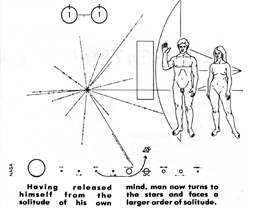 Man's first efforts at sending his thoughts beyond his own planet have taken a very ancient form. The first message, on a plaque aboard two Pioneer spacecraft launced in 1972 and 1973, featured a simple picture of two humans, one male and one female, the male holding up his hand in greeting, and drawings of the solar system, with a spacecraft emerging from the third planet. The next message, broadcast from the Arecibo radio telescope in 1974, included images of a radio telescope, the solar system, a DNA molecule, and a human. While it is true that this second message involved electromagnetic waves and a system of binary pulses to encode its meaning, these sophisticated devices were only employed to send a primitive picture.
Man's first efforts at sending his thoughts beyond his own planet have taken a very ancient form. The first message, on a plaque aboard two Pioneer spacecraft launced in 1972 and 1973, featured a simple picture of two humans, one male and one female, the male holding up his hand in greeting, and drawings of the solar system, with a spacecraft emerging from the third planet. The next message, broadcast from the Arecibo radio telescope in 1974, included images of a radio telescope, the solar system, a DNA molecule, and a human. While it is true that this second message involved electromagnetic waves and a system of binary pulses to encode its meaning, these sophisticated devices were only employed to send a primitive picture.
All the accomplishments since man first scribbled pictures in the sand have led us right back to where we began. The long development of writing — from that first pictograph all the way up to the binary code — has made it possible for us to begin making pictographs again. We have simply graduated to a higher level of isolation, and now we have to start all over by mastering the most elementary skills at this level. The sophisticated symbol systems we have worked out among
ourselves will not help us penetrate the minds among the stars, for those minds will not recognize our symbols or feel the meanings they were meant to evoke. To communicate with very different species we can only return to the simplest form of symbol available and work upwards from there.
Once again we are using pictographs to join brain to brain, but now the brain we are trying to reach is much vaster. Long ago human brains were isolated from one another, but now we have joined our brains in a planet-wide flow of thoughts.
Today we are trying to break out of the isolation of our planet and join a flow of thoughts that may fill the whole universe. Space may be swarming with energies carrying the thoughts of countless civilizations; thoughts may be flowing between galaxies like impulses leaping between neurons. Billions of galaxies may be involved in a massive metabolism of consciousness. The cosmos may be like a giant brain, a brain unbelievably rich in ideas and feelings and experiences. Thousands of years after we used pictographs to join isolated brains together, we now are using them to connect human brains to the cosmic brain.

Don Lago is a frequent contributor of articles and poems to COSMIC SEARCH. His article "Circles of Stone and Circles of Steel" was the First COSMIC SEARCH Award Winner, appearing in the March 1979 issue. His biographical sketch and photograph appeared with that article. Later articles were "A Hymn to Life in the Universe" in the Fall 1979 issue and "In The Time Machine" in the Spring 1980 issue. The latter article was subsequently reprinted in condensed form in Readers Digest.
A short version of this appeared in Science Digest where other articles by Don Logo have also been published.
|
|
The SEnTinel
By: Robert S. Dixon
Are We Listening for Machines or "People"?
Once again the gap between machine intelligence and biological intelligence has been narrowed. Researchers John Shoch and Jon Hupp at the Xerox Palo Alto Research Center in California have created a computer program that will migrate, reproduce and ultimately take over all the computers in a network. Their creation is called the WORM program, perhaps because it crawls through the wires interconnecting the various computers in a network, replicates itself in each one, and destroys whatever programs were originally running in the computers.
Shoch and Hupp have a network of 100 small computers connected together by the Ethernet technique. (Ethernet is a relatively new method now being promoted by Xerox, Digital Equipment, and Intel corporations.) Their work was described in the February, 1981, issue of "Data Communications Magazine". One night they left the WORM running in a few computers, and returned the next morning to find that dozens of the computers had been taken over and were "dead." They tried to restart some of the dead ones, but they would only run briefly before they were invaded by a WORM from some other computer again.
Fortunately, Shoch and Hupp also have a special Antibody program that can stop the WORM from growing. However, the antibody cannot restore the afflicted computers, so they have to have their memories individually cleared out and reloaded with their normal programs to resume operation. Shoch and Hupp can observe the progress of the WORM with a WORM-Watcher program, that can also limit the WORM's growth or kill it completely.
This particular WORM program can only exist in the specific kind of computers and network used by Shoch and Hupp, but with future development could perhaps function with dissimilar computers and various types of networks. A practical application of such a program is to search through a computer network for some information or data whose exact location is unknown, and then return it to the seeker.
Another application is to search for previously undetected malfunctions and defects in the network and report their existence.
The WORM program is but one of many recent examples of artificial intelligence. How long will it be before some computer attains the theoretically "perfect" level — one in which a human conversing via a computer terminal cannot tell if it is a machine or another person at the other end of the circuit. And if we recognize the possibility of building such a machine, we will have another unknown to consider if and when we ever receive radio signals from other civilizations — Are we listening to machines or to "people"?
•
A Russian SETI Experiment
Although several Russian SETI programs are believed to be in progress, very little detailed information about them has been published. A notable exception to this dearth of information is a recently published chapter in the book entitled Communication with Extraterrestrial Intelligence, edited by John Billingham and Rudolf Pesek (Pergamon Press, 1979). This book is a special issue (Volume 6) of the Journal Acta Astronautica, and contains many of the SETI papers given at the meetings of the International Astronautical Federation in the years 1975-77.
The experiment was actually carried out in 1972, by L.M. Gindilis (Sternberg State Astronomical Institute, Moscow), N.S. Kardashev, V.A. Soglasnov, E.E. Spangenberg, V. S. Etkin (all of the Institute of Space Research, Moscow), and V. G. Mirovskii (Lenin State Pedagogical Institute, Moscow).
Russian search strategies are generally the exact opposite of those used by most western experimenters. More precisely, they are the DUAL of western strategies. Whereas most searches seek narrowband, continuous signals, the Russian searches have concentrated on wideband, pulsed signals. The contrasts between these two approaches are shown in the table.
| Parameter | Western Strategy | Russian Strategy |
| Limiting Signal Bandwidth | Zero | Infinite |
| Limiting Signal Time Duration | Infinite | Zero |
| Dimension which must be searched | Frequency | Time |
| Use of directional receiving antennas | Yes | No |
| Number of receiving sites required | 1 | 2 or more, separated by thousands of kilometers |
| Effect of terrestrial interference | Blots out certain frequencies; can be identified by moving the antenna and by Doppler shift | Blots out certain times, can be identified by using multiple sites. |
| Method of determining transmitter distance | Parallax, over a period of time | Dispersion, immediately |
Both strategies have their strengths and weaknesses, and since no one knows the form of extraterrestrial signals, both strategies are necessary. The relative disadvantages of the Russian strategy are less sensitivity (since very small antennas are used) and the necessity of operating several widely-separated receiving sites simultaneously. These sites, however, can use relatively small (even portable) equipment that is inexpensive to operate.
The Russian strategy makes use of the fact that radio pulses are distorted by the interstellar medium in such a way that they arrive here first at higher frequencies and later at lower frequencies. A pulse that was originally transmitted at the same time on all frequencies will be received as a pulse that sweeps downward in frequency, like a descending chirp. The rate of descent is slower for signals arriving from farther away. Thus the aproximate distance of an interstellar
signal transmitter could be calculated from its apparent frequency sweep rate.
Gindilis and his co-workers used broadband receivers covering the frequency range 350-550 MHz, located at two sites separated by 3000 km. One was near the Black Sea in extreme southwestern Russia, and the other was in the Tadzhik Republic, near the southern tip of the Soviet Union. They recorded not only the output of these receivers, but the output of four 5 megahertz wide filters that selected portions of the total bandwidth near 371.5, 408, 458.5 and 535 megahertz. These four frequencies were chosen to have equal time delay between them for a dispersion-caused sweeping signal. For example, a transmitter 3000 light years away would sweep from one filter to the next in 1/2 second. The experiment lasted for approximately one month.
They found many pulsed signals, most of which were blamed on local interference, since they occurred at only one or the other of the two sites. A number of the pulses did, however, occur simultaneously at both sites. Some of the signals agree even down to very small details, so they cannot have come from the surface of the earth. After careful analysis of all the signals received, Gindilis and his co-workers concluded that their extra-terrestrial signals came from three separate causes — artificial earth satellites, bursts from the Sun, and sporadic radiation from the Earth's ionosphere. None of the signals had a dispersion that would place it outside the solar system.
This experiment was valuable in that it demonstrated the capability of the method to detect potentially interesting signals, and to positively identify interfering signals. The authors recommend that further experiments of this type be conducted using improved receiving and recording equipment.

|
|
College Courses on "Life in the Universe"
By: Editors
College courses on "Life in the Universe" are becoming increasingly popular. Although dealing mainly
with astronomy, many of the courses include much interdisiplinary material from such diverse areas as biology, medicine, psychology, physiology, semantics and communication.
We would like to include additional institutions. Please send information to Prof. John Kraus, Ohio State University Radio Observatory, 2015 Neil Ave., Columbus, Ohio 43210. Years given, attendance, a syllabus (if available) and other information will be appreciated.
In previous issues we have listed 30 colleges or universities offering or planning to offer courses. We list here another.
Institution: University of Toronto, Dept. of Astronomy
Instructor: Robert F. Garrison
Title: Life on Other Worlds. Full year credit course.
Content: Nucleogenesis, nucleosynthesis, evolution of planetary systems, solar system, spaceship Earth, Mars, beyond Mars, life beyond the solar system, interstellar life, interstellar communication, space colonies.
Textbooks: Asimov "Extraterrestrial Civilizations"; Goldsmith and Owen "The Search for Life in the Universe"
Years given: 8
Enrollment: About 200
|
|
Space Travel and Life Beyond the Earth
By: E. J. Öpik
Continued from the last issue in which Dr. Öpik discussed the conditions for life in the solar system.
Let us enquire whether the next step, this very long one, could be directed towards the stars—the so-called "fixed" stars which actually are not fixed at all but move even faster
than the planets; because of the enormous distances we do not notice much of these motions which can be detected only by accurate measurements. The stars are other suns, and many of them are far-away other solar systems. There undoubtedly are other planets, some lifeless, some carrying life—relatively few of the latter kind as can also be judged from what we know about our Solar System. Yet their distances are enormous to which, among other things, testifies their feeble apparent brightness when it is realized that, seen from an equally close distance, a star could equal, or even appear 10 to 100 times brighter than our Sun. The speed of light is 300,000 kilometers per second, 10,000 times faster than the motion of the Earth in its orbit or the velocity of an interplanetary vehicle; while this in turn could be a hundred times faster than the fastest jet planes. Yet despite its enormous speed, it takes 41/2 years for light to cover the distance from the nearest star, and about 300 years from a star chosen at random among the thousands seen in the dark sky at night. At the actual speed of our space vehicles it would take 40,000 years to reach and nearest star, and three million years to reach an average sun seen by the naked eye as a faint scintillating starlet. Man has always been tempted by far-away places, yet those distances are utterly prohibitive. Despite the thirst for knowledge and its philosophical lore (while no practical purposes could be served by a space journey of so long duration), hardly such a voyage will ever be undertaken. The journey could be made either in a state of artificial lethargic sleep, provided that medical science will ever tackle such a proposition; or by successive generations—hundreds of thousands of them, covering a span in time equal to that from our earliest Stone Age, over the entire prehistory and history of mankind until the Present. On Earth, during such a span of time, there appeared and disappeared entire races, nations and empires—how could ever survive and persist in its aims over a hundred thousand generations a tiny isolated human group lost in the immensities of space and time? Visits to the stars in such a manner are virtually impossible and unthinkable. Moreover, those scientific and philosophical aims which are underlying the plans would interest only the initiators of the expedition and, perhaps, their immediate descendants. Prospects of receiving an answer after one hundred thousand or a million years would hardly be conducive to such an expedition, and especially because its ultimate failure would be certain.
Could the speed of the space vehicles be accelerated and the time of travel thus shortened? The maximum physically possible speed is that of light, ten thousand times faster than the "normal" velocity of interplanetary vehicles. With such a speed a return journey to the nearest star would take 9 years. However, this nearest star, Alpha Centauri, may not be a very attractive goal; it is a double star which would not tolerate life-bearing planets within its domain; in the presence of those two suns the motion of a planet would be very complicated, with the mutual distances varying in the extreme, so that uniformity of a global planetary climate could not be maintained—lethal heat and deepest cold in succession blotting out all traces of life. Also, most of the planets of such a binary system would move on unstable orbits, being either ultimately ejected from the system, colliding between themselves, or swallowed by a sun (as is the fate of comets and other stray bodies in the Solar System). If we were in search of extraterrestrial life, thousands of stellar systems would have to be tried before one is found, at distances requiring centuries to be covered even at the speed of light. The outlook is entirely hopeless; humanity must content itself with its own Solar System, as must those other humanities lost somewhere in the depths of space in permanent isolation.
To make a material body move with the full velocity of light is impossible because it would require an infinite amount of energy. Even at near this velocity the energy per unit mass (initial or "rest mass") could by far exceed all sources of nuclear energy. Yet despite the seemingly virtual impossibility of attaining such high velocities, there are extraordinarily interesting outlooks connected with it, so that even scientists are repeatedly tempted to consider, theoretically at least, the consequences of locomotion at such ultimate velocities, and to search for loopholes to overcome the apparent technical near-impossibility.
Consciousness remains the ultimate mystery even though it is through it that we perceive the cosmos around us.
One of the consequences of motion with a velocity approaching that of light, according to Einstein's Theory of Relativity, is a foreshortening of time which in the departed vehicle advances slower than the body left behind, so that when the vehicle's velocity equals 0.995 that of light, a tenfold foreshortening takes place and a return trip to a star 50 light years away, recorded from Earth as of 100 years duration, would be recorded as only 10 years of life by the passengers in the vehicle. This strange fact is not simply a mere mathematical conclusion, but is confirmed by experiments in atomic physics where moving atoms represent the vehicles, their vibrations measuring time. The foreshortening is the greater the closer the velocity is to that of light.
Curiously, such foreshortening of time has been envisaged in some fairy tales. There is the story of Rip van Winkle; or Andersen's tale of Swamp King's Daughter, where the heroine is allowed to spend but one day in paradise with her deceased beloved and, returning to Earth, discovers that 1000 years have passed.
Despite such tempting prospects of a "time machine", there is a great obstacle which renders the project virtually impossible. The mass of the accelerated vehicle increases in the same ratio as time is shortened. Thus, even with the modest ratio of 10 to 1 as in the above example, each gram of the vehicle must be given 9 grams extra; now, according to Relativity theory and experiment, mass is equivalent to energy; it is actually the greatest concentration of energy we know, so that the extra grams of mass need a supply of energy equal to that of 1200 grams of a hydrogen bomb, or about ten times more of a "conventional" atomic bomb! If the rocket accelerator of the vehicle could use the strongest existing explosive, that of hydrogen fusion in the hydrogen bomb, acceleration to an 8-fold foreshortening of time would require an expenditure even of this super-fuel equal to 1037 times the mass of the vehicle (1 with 37 zeroes). At this rate, for one ton of the vehicle the amount of hydrogen to be spent should equal the mass of 10,000 million suns or almost that of the entire Galaxy.
Theoretically there could exist even a more powerful explosive or fuel than the hydrogen of the bomb: the mass of matter itself which, when converted into radiation, yields 128 times more energy than fusion of hydrogen. Mass is thus the ultimate possible source of energy, a source of which we have no idea how to tap it. One way would be to have a store of "antimatter" which, in contact with matter, annihilates completely. However, only single particles of atomic dimensions have been observed in the laboratory, and these annihilate instantaneously in contact with matter. To store antimatter is just as practicable (and infinitely more dangerous) than to store gunpowder in a burning fireplace. But even if storage were possible, to reach the desired "modest" time-foreshortening ratio of only 8, an amount of antimatter 3000 times the mass of the vehicle should be spent.
A sophism in Relativity, pertaining that the vehicle leaving the Earth, and the Earth left behind at an equal relative velocity are in equivalent states and should, therefore, have the same measure of time, is invalid: it is not velocity, but acceleration which pumps energy and mass into the vehicle; the vehicle is solely accelerated and the passengers would actually feel the acceleration as do those in an accelerated car, and not the by-standers watching it from the roadside.
To summarize—interstellar travel, visiting the stars or expecting visitors from the stellar universe, is at present not possible. We, as well as the inhabitants of other planetary systems, may be forever isolated in this respect.
This statement refers to material things having a finite rest mass, i.e. a mass even when they are not moving. Only an object which lacks a rest mass can be made to move with the velocity near that of light, because a zero increased so many times still remains a zero. Are there such objects?
Actually, light itself moves with the ultimate velocity whence its name. The waves of radiation, the photons, have no rest mass, only energy (and a kinetic mass appropriate to the energy). Therefore, time inside a photon stands still—at exactly the velocity of light the foreshortening is absolute. When measured by their "internal time" (if such a notion is permissible), the photons can traverse the entire Universe in an instant of their own time, although in our measure the time between the emission of a photon and its absorption by a body somewhere on the outskirts of the Universe would amount to thousands of millions of years or to anything short of infinity.
The analogy of the timeless photon could suggest possibilities for grasping (not solving) the greatest mystery of our experience — that of our consciousness, or our "soul". Its nature is not accessible to physical experiment, it is not subject to the laws of physics, to measurements or timing: it is immaterial. Being immaterial and massless, it could be timeless as the photon, moving with the speed of light in an instant (by its own timing) through the immensities of space. As a mere suggestion for an insoluble mystery — could it be that the immortal soul, the individual unit of consciousness, would move through the infinities of space and time, after leaving one body, to find another and cooperate with it, like the absorbed photon transmitting its energy when absorbed? We do not know; the nature of consciousness, of the soul remains the ultimate mystery, despite the fact that consciousness to us is the only incontestable reality, through which we perceive the world around us.

Dr. Öpik has written numerous articles on life and intelligence in the universe. Recently he reviewed his monograph "The Sun", published in 1919 and noted how much of our basic concepts of cosmic evolution have persisted despite new observational facts, and how little has changed. The age of the Earth in 1919 was underestimated at a few hundred million years, while that of the stars reckoned in thousands of millions. The prophetic suggestion of immense energy sources in stellar interiors was a forerunner of modern concepts of nuclear energy sources. The outmoded representation of stellar spectral types as a continuous evolutionary sequence is no longer valid, as well as the description of solar evolution by continuous "cooling" and dimming. This must now be replaced by a future brief heating up, ultimately followed by a real cooling—a collapse into the white dwarf stage to which the offered description of a frozen end of the world could still apply.
The monograph was written at Moscow Observatory during the privation year of 1919. There was no fuel, and ink was frozen hard on the writer's desk. In the biting cold and with a dim electric light available, the writing was done in pencil, in bed under a blanket—a foretaste of a freezing dying world of the future.
|
|
People
By: John Kraus
After the space shuttle Columbia's pioneering flight, John Glenn, U.S. Senator from Ohio and first U.S. astronaut to orbit the earth, wrote one of his constitutents about the space program as follows:
The direction and emphasis of our efforts in space have changed a great deal since I was associated with the program. In those early years the emphasis was on simply putting a man into space and bringing him safely home. Today, the benefits of further manned exploration do not justify the tremendous expenditures such ventures require. But this does not mean we should give up on the space program. On the contrary, we can secure many additional rewards by continuing our efforts in space.
The justification for our space program lies in the benefits it produces for us in the here and now, benefits that enhance the lives of each and every one of us. Consider the following:
Countless thousands of human lives and millions of dollars have been saved through satellite warning of hurricanes, typhoons, and severe storms.
Advanced weather forecasts have increased crops yields all around the globe.
Communications satellites are bringing us all closer together, linking continents at half the cost of just ten years ago.
Aircraft, automobiles, ships, and buildings are now more structurally sound, safer, and more economically constructed thanks to structural analysis techniques developed by NASA.
Our country as a whole is more secure because observation, reconnaissance and early warning satellites have made a surprise attack on the United States less feasible, and therefore less likely.
Indeed, experts estimate that the cost/benefit, return on investment ratio for the space program may be as high as 8-to-1.
In this light it is more than simply troubling that the Administration has proposed devastating cutbacks in NASA's budget; indeed, in the entire Federal research budget. I fully recognize the need for budgetary restraint in these inflationary times. But we must not be penny wise and pound foolish. We must not demonstrate our frugality by mortgaging the future.
Basic research represents nothing less than the key to our future. In today's world, our economic and military strength depend upon boosting our efforts in this area. Failing to meet this challenge is the surest way to forfeit our claim to world leadership. It's just that simple. For these easons, I will continue to press for sufficient funding for NASA and other agencies involved in the quest for knowledge.
Sincerely,
John Glenn
United States Senator
•
Gerard K. O'Neill, Professor of Physics at Princeton University, has published a new book "2081: A Hopeful View of the Human Future" (Simon and Shuster, May 1981) in which he predicts what he believes the world will be like a hundred years from now. He foresees great improvements in transportation on the earth using fast magnetic propulsion through underground pipelines. He also believes that travel to and from space colonies will be commonplace and routine for millions of people.
O'Neill is President of the Space Studies Institute, a non-profit corporation conducting and sponsoring space research.
An exclusive in-depth interview with Dr. O'Neill on "Space Colonization and SETI" appeared in the March, 1979 issue of COSMIC SEARCH.
•
The Reverend Theodore M. Hesburgh plans to retire as President of the University of Notre Dame in May or June 1982. Upon his retirement as President, a position he will have held for 30 years, it is reported that he is to be named Chancellor of the University.
Dr. Hesburgh is a member of the Editorial Board of COSMIC SEARCH. In the last issue of the magazine it was noted that an asteroid had been recently named for him.
•
Bernard Oliver, Vice President for Research and Development of the Hewlett-Packard Company of Palo Alto, California, has made a $20,000 grant to the Extrasolar Planetary Foundation to assist in their program to discover planets of other suns. Dr. George Gatewood, Chairman of the Extrasolar Planetary Foundation, writes regularly in COSMIC SEARCH about the plans and progress of the Foundation.
In the last issue of COSMIC SEARCH we reported on Dr. Oliver's $200,000 grant to the Monterey Institute for Research in Astronomy to assist in their proposed plan to study stars in the solar neighborhood and acquire better statistics on those that may be good SETI candidates. Dr. Oliver is a member of the Editorial Board of COSMIC SEARCH.
•
A Society of Amateur Radio Astronomers (SARA) has recently been formed. According to Robert W.P. Patterson, Vice President of the Society, this new non-profit organization seeks to promote amateur studies in the field of radio astronomy and to serve as a forum for discussions of projects, techniques and results. Annual dues are $10. Additional information can be obtained from Jeffery M. Lichtman, President S.A.R.A., 81 Stony Hill Road, Feeding Hills, Maine 01030.
•
The Astronomical Society of Australia is holding a "Space Day" on August 9th of this year to promote public awareness of and interest in space research and astronomy. For more information contact Mrs. Jane L. Brooks, 31 Avenue St., Millswood, South Australia 5034.
•
The Astronomical Society of the Pacific has announced its 1981 award winners. The Catherine Wolfe Bruce Medal goes to Dr. Riccardo Giacconi of the Center of Astrophysics at Harvard for his lifetime contributions to astronomy. The Robert S. Trumpler Prize has been awarded to Dr. Richard Kron of the University of Chicago for his outstanding Ph.D. dissertation in astronomy. The Dorthea Klumpke - Roberts Award goes to Dietrick Thomsen, Senior Editor of Science News for his outstanding contributions to public understanding of astronomy. Winner of the Astronomical Society of The Pacific Amateur Achievement Award is George E. Alcock of Peterborough England for his contributions
to the field of astronomy by an amateur.
•
A number of groups interested in promoting increased utilization and exploration of space are designating July 13 to 20 of this year as "Spaceweek" on the twelfth anniversary of the Apollo Moon landing. The theme will be "Space: America's New Wealth." Meetings are scheduled in major cities of the U.S. For more information write to Spaceweek National Headquarters, P.O. Box 58172, Houston, Texas 77058 or call Dennis Stone 713-333-8280.
JK
|
|
In Review:
By: Robert H. Van Horn
COMMERCIAL OPERATIONS IN SPACE 1980-2000. Volume 51, Science and Technology, 1981, 214 pages, Hard Cover $30; Soft Cover $20. SHUTTLE/SPACE LAB — THE NEW TRANSPORTATION SYSTEM AND ITS UTILIZATION, Vol. 43. Advances in the Astronautical Sciences, 1981, 342 pages, Hard Cover $45; Soft Cover $35. Published by the American Astronautical Society. P.O. Box 28130, San Diego, CA. 92128.
These companion volumes give an overview of the present state of engineering planning for civilian utilization of space. Solar power collected in space and transmitted to power grids on earth, exotic new materials from space, scientific experiments free of atmospheric distortions, all these and more have advanced to realistic engineering planning stages. These plans are set forth in these volumes in considerable detail.
Each volume represents the Proceedings of an engineering conference and contains the texts of the engineering papers presented at these conferences. Each paper can be read independently of the others. The reader does not need a Ph.D. to read the papers with profit, but a general understanding of technical material would be most helpful.
COMMERCIAL OPERATIONS IN SPACE 1980-2000 covers the proceedings of the 18th Goddard Memorial Symposium (1980). It contains eighteen papers, all but two by authors directly or indirectly associated with NASA programs. The two exceptions are French papers dealing with future commercial operations in space. One in particular makes a comparison between the USA's Space Shuttle and the European Space Agency's ARIANNE project. The Space Shuttle uses reuseable vehicles to launch working payloads into orbit, while ARIANNE is based on the use of expendable vehicles. After looking in detail at technical and economic pros and cons, the author suggests that the two concepts may be usefully complementary.
Other papers in COMMERCIAL OPERATIONS deal with the economic outlook for private commercial operations in space, manufacturing facilities for making new materials in the ultra-clean gravity-free environment of space, space vehicle design, use of satellites to survey earth resources or to collect solar power for transmission to earth, etc. New materials that can be made only in space may have the greatest impact on us as consumers. The absence of gravity will make possible the manufacture of metallic alloys with new and unique properties, reinforced metals or polymers, crystalline materials and pharmaceuticals.
SHUTTLE/SPACELAB covers the proceedings of the Third German Association for Air and Space Travel/American Astronautical Society Symposium held in Hannover, West Germany in April 1980. It presents twenty three papers on topics similar to those covered in COMMERCIAL OPERATIONS. About half the papers are of European origin, mostly West Germany. Several of the German papers deal with plans for operating scientific laboratories. One paper worth a special note is by an American team and describes a new design for Solar Electric Propulsion System. Such a system would use solar energy collected by the vehicle to generate high speed ion beams for thrusting the vehicle into the desired orbits. The author claims that such a system, "will bring about another order of magnitude increase in mankind's capability for exploring deep space."
These volumes would be valuable additions to the libraries of everyone having a serious working interest in space exploration and utilization.
|
|
Perpetual Index
By: Editors
Vol. 1, No. 1, January 1979
"Searching for Interstellar Communications" by Giuseppi Cocconi and Philip Morrison
"Twenty Years After . . . " by Philip Morrison
"A Reminscence of Project Ozma" by Frank D. Drake
"Little Green Men, White Dwarfs or Pulsars?" by S. Jocelyn Bell Burnell
"Trouble in Aquila" by Arthur C. Clarke
"Rendezvous with Infinity" by Norman Cousins
"Time and a Cosmic Perspective" by Richard Berendzen
"What If We Succeed?" by Walter Sullivan
SETI Forum: An interview with Sebastian von Hoerner
Vol. 1, No. 2, March 1979
"The Quest for Extraterrestrial Intelligence" by Carl Sagan
"Circles of Stone and Circles of Steel" by Don Lago
"Space Colonization and SETI": an interview with Gerard K. O'Neill
"The Case for SETI" by Richard Berendzen
"Generalized Life" by Jerome Rothstein
"Man's Role in the Galaxy" by R.N. Bracewell
Vol. 1, No. 3, Summer 1979
"Neutrinos for Interstellar Communication" by Jay M. Pasachoff and Marc L. Kutner
"Extraterrestrial Politics" by Michael A.G. Michaud
"Bio-Cosmology: A New NASA Thrust" by B.M. Oliver
"Minds and Millenia: The Psychology of Interstellar Communication" by Michael A. Arbib
"We Wait and Wonder" by John Kraus
"Extraterrestrial Life: Where is Everybody?" by Jesco von Puttkamer
Vol. 1, No. 4, Fall 1979
Forum: An interview with John A. Wheeler
"My Brother Karl Jansky and his Discovery of Radio Waves from Beyond the Earth" by C.M. Jansky, Jr.
"What It Was Like Before Ozma" by Louis Berman
"A Hymn to Life in the Universe" by Don Lago
"Quest Beyond the Stars: Are We Alone?" by Jesco von Puttkamer
"The Possibility of SETI From Space" by Roy P. Basler
Vol. 2, No. 1, Serial No. 5, Winter 1980
"The Grand Analogy: History of the Idea of Extraterrestrial Life" by Trudy Bell
"It's a Nice Planet to Visit, but I Wouldn't Want to Live There" by Virginia Trimble
FORUM: Billingham on NASA and the Exploration of Space
"A Strange Radiation from Above" by John Kraus
"Strategies for the Search for Life in the Universe: A Joint Session of the International Astronomical Union" by Michael Papagiannis
"Towards a Cosmic Language" by Hans Freudenthal
Vol. 2, No, 2, Serial No. 6, Spring 1980
"The Aliens in Our Oceans: Dolphins as Analogs" by Bruce E. Fleury
"Marconi" by George H. Brown
"The Chief Entities" by I.J. Good
"Communication with Extraterrestrial Intelligence" (Munich conference) by Jill Tarter
"Life in the Universe" (Paris conference) by Jill Tarter
"Where Are They" (Maryland conference) by Virginia Trimble
"Space Industrialization: Opportunity for Space Science" by G. Harry Stine
"In the Time Machine" by Don Lago
"Allocating the Radio Spectrum" (Geneva conference) by Vernon Pankonin
Vol. 2, No. 3, Serial 7, Summer 1980
"Putting Our Best Signal Forward" by Leonard and David
"A Speculation on the Influence of Biological Immortality on SETI" by Frank D. Drake
"Diana Waves Back: The First Moon Bounce" by John Kraus
"Confronting Political Realities" by Marcia S. Smith
"Strategies of Searching for Extra-Terrestrial Intelligence" by Nikolai Kardashev
"Science Communication in the Mass Media" by Joan Lurie
Vol. 2, No. 4, Serial 8, Year End 1980
"The Recognition of Alien Biospheres" by James E. Lovelock
"Strategies of Searching for Extra-Terrestrial Intelligence (Part Two) by Nikolai Kardashev
"SETI" by Frank D. Drake
"Why is Scientific Writing Unintelligible?" by Sharon Dunwoody
"Technical Development and Colonization as Factors in the Long-Term Variation in Limits to Growth" by Brian A. Tinsley
"In Search of Extrasolar Planets" (EPF Report) by George Gatewood
Vol. 3, No. 1, Serial 9, Winter 1981
"SETI and the Spectral Classification of Stars" by John Bahng
"Not As We Know It" by Isaac Asimov
"In Which Klingons Become Chimeras" by Frank Drake
"Universal Chemical Evolution" by Robert Rubin
"ETI in the Classroom" by Philip Barnhart
Vol. 3, No. 2, Serial 10, Spring 1981
"Space Travel and Life Beyond the Earth (Part 1 )" by E.J. Opik
"On Intelligence: A Wave of the Past and Future" by Frank D. Drake
"What Makes Atoms Tick" by Earle Holland
"The Next Best Thing to Being There" by William R. Dodson
"The Nature of Extraterrestrial Communication" by Robert E. Kuttner
"Intra-terrestrial Intelligence" by W.A. Rhodes
"In Search of Planets" by George Gatewood
|
|
The Cereal Box Syndrome
By: Robert A. Freitas, Jr.
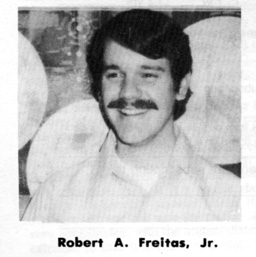 SETI* (*Search for Extra-Terrestrial Intelligence) has long been the province of the radioastronomer. While this, in itself, is neither bad news nor good, these early workers and their attitudes have left an indelible imprint on the field that persists to this day. One year after Cocconi and Morrison first seriously proposed a search at the 21-cm wavelength, Ronald Bracewell suggested the use of interstellar spaceprobes for communication among sentient races. However, many SETI workers for years have virtually ignored this possibility, and have maintained that listening for radio signals of intelligent extrasolar origin is the only reasonable way to open up interstellar communications. All this stuff about traveling around the universe," remarked one well-known American radio physicist in an oft-quoted passage, "belongs back where it came from, on the cereal box."
SETI* (*Search for Extra-Terrestrial Intelligence) has long been the province of the radioastronomer. While this, in itself, is neither bad news nor good, these early workers and their attitudes have left an indelible imprint on the field that persists to this day. One year after Cocconi and Morrison first seriously proposed a search at the 21-cm wavelength, Ronald Bracewell suggested the use of interstellar spaceprobes for communication among sentient races. However, many SETI workers for years have virtually ignored this possibility, and have maintained that listening for radio signals of intelligent extrasolar origin is the only reasonable way to open up interstellar communications. All this stuff about traveling around the universe," remarked one well-known American radio physicist in an oft-quoted passage, "belongs back where it came from, on the cereal box."
It seems to be the nature of this "Cereal Box Syndrome" that those affected seldom recognize their affliction. This is a potentially serious problem as radio-based SETI research enters the megabuck funding range and thereby risks unnecessarily "pricing itself out" of an already parsimonious market. Alternative less-expensive search programs based on the concept of advanced spacefaring automata have been devised and continue to be developed. Why, then, the traditional intellectual hostility to the idea of interstellar missions?
The first reason is simply the lack of interested practitioners. A mere handful of lucky individuals are fortunate enough to be able to devote their full time to SETI, and perhaps only a few hundred others can manage a part-time commitment to the field. There simply are not enough people to properly investigate all possibilities. The genesis of SETI was in radio astronomy and radio physics, and these elements, aided by the presence of a few rather strong-willed personalities, have combined to create a kind of snowballing effect. That is, the emphasis on radio techniques is most diligently studied, hence gains more respectability, thus attracts more workers, whose work adds yet more credibility to the effort, and so on.
A second cause of the Cereal Box Syndrome is the frequent confusion of the issues of interstellar travel and interstellar probes. The first may imply a manned component; the latter generally does not. Too many SETI scientists have been stung by the "UFO" issue. Understandably, they are reluctant to associate themselves with any endeavor which might be misinterpreted by the public as endorsing alien visitations or be scorned by academic colleagues as credulous. But manned and unmanned missions are entirely different things. Interstellar vehicles which must be man-rated, protected against the hostile hard-vacuum high-radiation environment of space, carry expendables able to support human life for decades or centuries and permit a return voyage may be vastly more complex and expensive than fully-automated unmanned spaceprobes on one-way trips.
The third reason for hostility to the notion of interstellar flight as a significant factor in SETI is the physical and economic argument that extrasolar missions are grossly impractical. However, as Robert Forward of Hughes Laboratories has often pointed out, in each case the only thing proven is that various sets of initial assumptions can be chosen to give the appearance of immense difficulty. Recently a group of scientists and engineers working under the auspices of the British Interplanetary Society on "Project Daedalus" produced, after a five-year study, a preliminary design for an automated starship vehicle capable of exploring out to about 10 light-years from the Sun. They concluded that such a mission may become feasible for humanity sometime in the next century.
Calculations showing that the energy required to launch spacecraft to the stars is equal to the total U.S. power generation for a century or will cost 100 gross national products (GNP) are really irrelevant to SETI. This is because these computations chauvinistically presume current human society to be the standard of comparison for the entire universe. Yet almost certainly any race capable of transmitting either radio signals or interstellar probes for SETI purposes must be far in advance of ourselves, possibly on the level of a Kardashev Type II civilization (utilizing a major fraction of the energy output of their sun). It is a simple matter to calculate that to launch a 100,000 ton vehicle on a one-way trip at 1-gee acceleration to a destination 100 light-years away would require an equivalent relative energy expenditure for a Type II civilization as the launching of a few Saturn V rockets represented to American society a decade ago (about one percent of the GNP annually). Clearly, active interstellar exploration by advanced cultures will require commitment — but hardly an outrageous sacrifice.
The last factor contributing to the pervasiveness of the Cereal Box Syndrome is the lack, until recently, of a well-defined observational program to search for probes such as now exists for radio-SETI. Ronald Bracewell originally proposed that a circular circumsolar orbit somewhere within the stellar "habitable zone" for carbon-water life might be the most logical place to park a visiting extraterrestrial messenger craft, though this represents a rather large search volume. Other suggestions have included the lunar surface by M. W. Saunders, the Earth/Moon Lagrangian points L4 and L5 by Anthony Lawton, the Asteroid Belt by Michael Papagiannis, and Lagrangian "halo orbits" generally by myself. Additional (and surprisingly inexpensive) search proposals are currently being developed, and the first explicit SETI search for Earth-orbiting interstellar probes was recently reported in Icarus (Vol. 42, June 1980). This program was conducted at a total cost of about three hundred dollars.
Twenty years after the historic OZMA project, the serious search for extraterrestrial artifacts in our Solar System has finally begun.

 Robert A. Freitas. Jr., is a science writer and editor. Born in Camden, Maine, in 1952 he received his Bachelor's degree in Physics and Psychology from Harvey Mudd College, Claremont, California, in 1974 and his Juris Doctor degree from the University of Santa Clara Law School in 1978, specializing in international and space law.
Robert A. Freitas. Jr., is a science writer and editor. Born in Camden, Maine, in 1952 he received his Bachelor's degree in Physics and Psychology from Harvey Mudd College, Claremont, California, in 1974 and his Juris Doctor degree from the University of Santa Clara Law School in 1978, specializing in international and space law.
Dr. Freitas is Director of Space Initiative which publishes "Lobbying for Space: The space Lobbyist's Handbook" and provides information on Congressional voting records and other materials useful for promoting increased activity in space. He has written numerous papers and articles which have been published in the Journal of the British Interplanetary Society, Mercury, Omni, Analog, Astronomy and other journals. Currently he is writing a book "Xerology", a comprehensive scientific treatment of the subject of SETI and life beyond the earth. This summer Dr. Freitas is participating in a NASA Goddard — University of Maryland sponsored program on "Computer Science, Key to a Space Program Renaissnace."
|
|
Letters:
By: Editors
Letters are always welcome but owing to the volume it is not possible to acknowledge all of them. Also due to space limitations we reserve the right where necessary to condense or edit the contents. Letters may be addressed to: Editorial Dept., COSMIC SEARCH, P.O. Box 293, Delaware, Ohio 43015.
This is Frank Drake's response to the letter by Tom Van Horne in the last issue:
Much as I enjoy the company and personalities of other radio astronomers, I surely don't relish the idea of everybody being one of them! No, I think the mix of personalities and talents in our population will not change very much in the future, except that there will be a much smaller percentage of manual laborers. More to the point, I think the typical person will still not be an intellectual and will have the ambitions and desires of our era. A good life, adventure, a chance to raise the standard of work and living.
Such people will not want interstellar colonization when they consider the cost. Even if you have a good fusion reactor, which does go a long way towards making interstellar travel possible, the energy required is still enormous and could be used to much greater benefit right back home. The energy picture, and the relative benefits of employing the energy near home or in deep space do not change no matter what breakthroughs occur.
The only believeable reason I accept for interstellar colonization is chauvinism. Do They really embrace it, and launch their colonies despite the horrendous loss to Them? This is a question in galactic sociology, and even the most confident of the SETI people doesn't claim any skill at that subject, yet.
As to the question of whether radio waves are the best means of interstellar communication, well, we do know a lot more about physics and the universe than the scientists of the 19th century. We know enough of the very basic physics of the universe to conclude that radio waves are a very promising way to go, although everyone agrees that we should be alert for signs of life in other forms of radiation. It is very unlikely that there is some potential form of communication, some mysterious "Q-waves" which we do not know about. But not completely impossible. In any case, we should not defer the promising radio searches because of the remote possibility that Q-waves exist.
Frank D. Drake
•
Dr. Drake's "In Which Klingons Become Chimeras" in the Winter 1981 issue contains a good summary of the argument advanced recently against the existence of extraterrestrials. However, the points he makes against the argument need qualification. It is not the absolute amount of energy a project will need but the percent of the total energy budget of a civilization which determines if a mission is impossible. In 1900 the total energy budget of the U.S. was not equal to the first stage of a Saturn 5 moon rocket. Sixty-nine years later the total energy available to the U.S. had grown to the point where a moon Mission was possible.
As to Dr. Drake's contention that intelligent beings will be logical, the only example we know, i.e. humanity, is not always logical. For example, in his article he links his opponent's argument with a "disease" and by giving that "disease" a name, "Star Trekitis," tends to identify the argument with the still slightly disreputable sub-culture of science-fiction.
The only way to decide between Dr. Drake's position and his opposition is to gather more data and this is the best argument for proceeding with all kinds of searches.
Lawrence Boyle
Chicago, Illinois
Mr. Boyle raises a very fundamental and provocative question which is of great interest in its own right, as well as in its importance in determining the best approaches to SETI. Is it the absolute or relative amounts of energy which will control a civilization's decisions about interstellar enterprises? Would that we knew something about this prime question of galactic sociology! Mr. Boyle believes that the relative amount of energy dominates decision making. Then we can speculate that sources of energy so copious will finally be developed that almost anything, even interstellar colonization, will be justified and attempted. I think this is true up to a certain level of energy supply, beyond which the absolute amount of energy required to do things will control decisions. At this stage, choices will be made between various appealing alternatives. As an analog, imagine a family so wealthy that they can travel anywhere they wish. I suspect that they may go to the Antarctic once, just to see what it is like, but from then on their resources will be expended in places such as Tahiti and Paris. Returning to the extraterrestrials, I think they may dabble in interstellar exploration, but will primarily turn to terraforming their own planetary system.
Mr. Boyle makes a very important point which every thinking person should draw from discussions like that above. We do not know enough to phyche [sic; "phyche" should be "psyche"] out the extraterrestrials. It is sheer folly to think that we can predict galactic sociology. What we need is data, as Mr. Boyle emphasizes. SETI, for now, is very much an experimental science. Even there we cannot by sure what is best. We should support any cost-effective approach to SETI which, even at the greatest stretch of the imagination, might find evidence of extraterrestrial life.
Frank D. Drake
|
|
ABCs of Space
By: John Kraus
What Is Gravity?
The nature of gravity was obscure to early watchers of the sky who believed that the earth was flat and stationary with the sun, moon, planets and stars moving around it. The idea that the earth was a spinning sphere revolving around the sun began to gain slow acceptance after Nicholas Copernicus of Poland drew attention to the concept in 1543.
In 1582 with the financial support of King Frederick II of Denmark, Tycho Brahe built the best equipped observatory of his day and for three decades carried out very accurate and complete measurements of the positions of stars and planets. Subsequently, Brahe's observations were analyzed by Johannes Kepler from Germany who deduced from them that the orbits of the planets, although approximately circular, are actually ellipses with the sun at one focus.
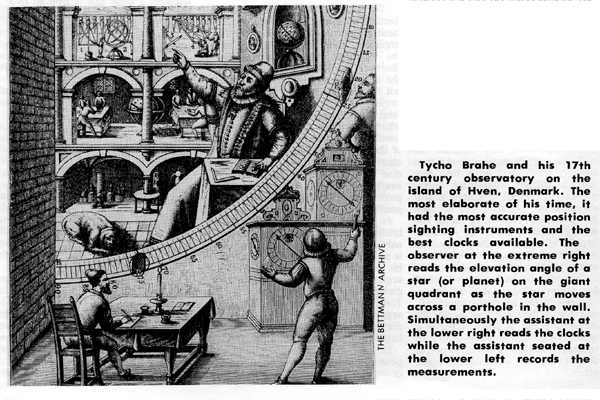

The foundations had been laid and in 1687 Isaac Newton of Cambridge University, England, enunciated his famous Law of Universal Gravitation describing the force of gravity or attraction between two objects, such as the sun and a planet. According to Newton's law, the two objects are attracted by a force that increases in proportion to the product of their masses and decreases in proportion to the square of the distance between them.1(1. Gravitational force=GMM'/R2 where M and M' are the two masses, R is the distance between them and G is the universal gravitational constant.) Newton's derivation of the law depended in a crucial way on Kepler's deductions about planetary motions based on Tycho Brahe's observations. Not only is it a law for planetary motions but also one which tells us, for example, that the force holding an astronaut to the moon is 1/6 that on the earth, or in other words, that the astronaut weighs only 1/6 as much on the moon.
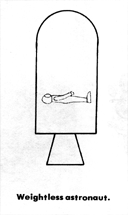
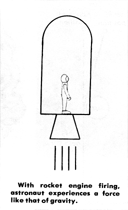 To answer the question, "What is gravity?" it is essential to appreciate that gravity and acceleration are equivalent. Consider an astronaut floating weightless in a space craft. He fires a rocket on the craft causing it to accelerate and immediately he finds himself being pressed to the rocket end of the craft. Rising to his feet he can stand firmly on the floor over the rocket engine. If the acceleration is sufficient to make his weight the same as when standing on the earth, it is said that the acceleration amounts to 1 g (that is, it is equal to the force of gravity at the earth's surface). With all portholes closed and communication with the outside cut off there is no experiment the astronaut can perform inside his craft that would tell him whether he is moving in space or parked on the launching pad on the earth. Acceleration and gravity are equivalent.
To answer the question, "What is gravity?" it is essential to appreciate that gravity and acceleration are equivalent. Consider an astronaut floating weightless in a space craft. He fires a rocket on the craft causing it to accelerate and immediately he finds himself being pressed to the rocket end of the craft. Rising to his feet he can stand firmly on the floor over the rocket engine. If the acceleration is sufficient to make his weight the same as when standing on the earth, it is said that the acceleration amounts to 1 g (that is, it is equal to the force of gravity at the earth's surface). With all portholes closed and communication with the outside cut off there is no experiment the astronaut can perform inside his craft that would tell him whether he is moving in space or parked on the launching pad on the earth. Acceleration and gravity are equivalent.
If the force of gravity can be replaced by an acceleration, then, according to Einstein, it cannot be like the force exerted by a bulldozer. Instead it must represent a special property of 4-dimensional space (3 coordinate dimensions plus time) in which the gravitational effect of a mass is equivalent to a curvature of the space.
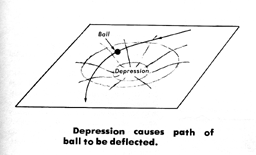
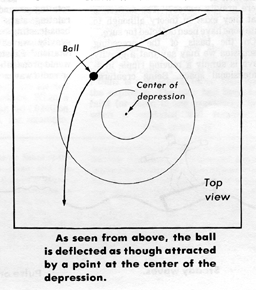 By analogy consider a ball rolling on a plate having a slight depression. As the ball enters the depression its path is bent inward. Looking at the plate from above, and being unaware of the depression, we might think that the ball was attracted by a point at the center of the depression. Thus, Einstein could look at gravity as a space curvature.
By analogy consider a ball rolling on a plate having a slight depression. As the ball enters the depression its path is bent inward. Looking at the plate from above, and being unaware of the depression, we might think that the ball was attracted by a point at the center of the depression. Thus, Einstein could look at gravity as a space curvature.
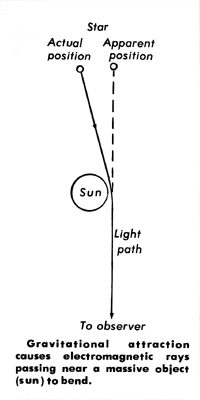 Now if space is curved near a massive body, such as the sun, Einstein concluded that electromagnetic rays, following the shortest path from a star to the earth, would be bent if they passed near the sun or other celestial body. Observations have been performed at both optical and radio wavelengths indicating that this is indeed the case. In effect one can see behind a massive body. Around a black hole, space is curved or curled to such an extent that electromagnetic waves are trapped by it.
Now if space is curved near a massive body, such as the sun, Einstein concluded that electromagnetic rays, following the shortest path from a star to the earth, would be bent if they passed near the sun or other celestial body. Observations have been performed at both optical and radio wavelengths indicating that this is indeed the case. In effect one can see behind a massive body. Around a black hole, space is curved or curled to such an extent that electromagnetic waves are trapped by it.
Another question we may ask is, "Are there gravity waves?" The answer is that they exist in theory although to date none have been detected for sure.
On the basis of the preceding discussion we may say that a gravity wave is simply a moving ripple in 4-dimensional space. Being creatures accustomed to a 3-dimensional world it is difficult to visualize a 4-dimensional space so we resort to analogies. The analogy here would be that of a ball on a taut flexible sheet rippled by a wave traversing it. The ball would be accelerated first one way and then the other as the ripples pass by causing the ball to oscillate back and forth.
Gravity waves of considerable strength could be produced by two stars rotating around each other. The co-rotating stars form a gravitational broadcasting station beating out gravity waves in rhythm to their rotation.2(2. See "ABCs of Space," COSMIC SEARCH, vol. 2, no. 1, Winter, 1980, page 28; "Our Cosmic Universe" by John Kraus, Cygnus-Quasar Books, 1980, page 211. The most complete reference on gravity, gravity waves etc. is the 1279 page book "Gravitation" by Charles W. Misner, Kip Thorne and John A. Wheeler, W.H. Freeman and Co., 1971.) Einstein assumed the waves would propagate with the speed of light or radio waves (300,000 kilometers per second) but this has yet to be verified experimentally.
Gravitational energy may also be radiated when a star collapses into a neutron star (pulsar) or a black hole. In this case the principal radiation would probably be in a short pulse and not in sustained, steady waves as for the co-rotating stars. By analogy a man rocking a boat sends out steady waves but a stone dropped in a pond produces only a few waves, a pulse, which spreads out in a ring. Gravity waves would carry valuable information about star collapses, explosions and other violent events in the universe.

|
|
Time and a Cosmic Perspective
By: Richard Berendzen
A random sample of COSMIC SEARCH readers responded to a recent questionnaire that, of the articles they liked, this one by Dr. Richard Berendzen was one of the very best. We reprint it here as it appeared in the premier issue of COSMIC SEARCH. Dr. Berendzen is a member of the Editorial Board of COSMIC SEARCH. Now President of the American University, he was Provost when this article appeared. — Ed.
Time. We kill time, spend time, lose time, make time, beat time, take time, waste time; but we virtually never consider time, much less understand it. Yet to view events properly and possibly even to perceive ourselves in rightful context, let us go back in time, even to its beginning.
For countless ages there truly was darkness on the face of the deep. Then, some 18 billion years ago, a cataclysmic explosion brought forth the cosmos itself. This was the birth of the universe. Even today we live in the lingering remnant of the radiation produced by that titanic blast. Some billions of years after the explosion, large ensembles of material clumped because of their mutual attraction. And so the protogalaxies were born. In those early galaxies, some of the gas and dust congealed by its own gravity to form large, amorphous, spherical balls, which slowly shrank and ultimately flickered into light. And so the stars were born. In the hearts of those stars, nuclear furnaces raged. In a form of stellar alchemy, hundreds of millions of tons of hydrogen were converted into helium every second. And so they have burned for all these billions of years.
"Without astronomy we could not understand this epic, this cosmic perspective."
As the stars formed, debris was left behind. Some of it became planetary systems around the stars. On some of those planets there must have been early atmospheres, perhaps similar to the earth's in its primordial days. In some of those atmospheres there must have been the very chemicals that brought forth life here. All current evidence compellingly suggests that the same processes that operated here might well have operated elsewhere, possibly thousands or millions or even hundreds of millions of times. If so, life may have flickered into existence on those planets, and some of that life may have been intelligent.
Billions of years went by, with galaxies forming and stars burning, expanding, exploding, shrinking, collapsing, dying. Then, some five billion years ago, on the remote periphery of an average galaxy in an unexceptional part of the universe, a particular star was born. On piece of debris number 3, special events were to take place; several billion years later the chemical and biological processes of that young planet's atmosphere and oceans yielded a strange new apparition —Homo sapiens, man.
After more eons elapsed, man evolved, creating societies and civilizations and education and nations and war and peace and law and science and technology and our modern world. And here we are in the year marked in time as 1979.
In such a cosmic sweep through space and time, any rational person must feel an almost overpowering smallness. Our day-to-day concerns and trite prejudices shrink into microscopic, infinitesimal nothingness.
Yet there is another side, and it gives dignity and worth to life itself. For even though our physiques are but specks in space and our life-spans but ticks in time, we nonetheless are capable of comprehending a system far vaster than ourselves. Our ethical and moral concerns, together with this ability, constitute some of the most ennobling characteristics of humankind.
Without astronomy we could not understand this epic, this cosmic perspective. And it is worth knowing.

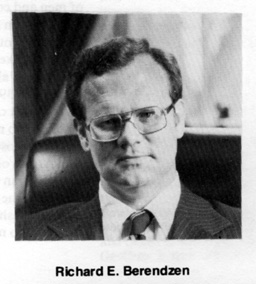 Richard E. Berendzen was born in Walters, Oklahoma, in 1938. He received a Ph.D. degree from Harvard in 1967. Joining the physics faculty at Boston University, he became department chairman in 1971. Three years later he went to the American University, Washington, D.C., where he is now University Provost. Dr. Berendzen is the author of several books including "Man Discovers the Galaxies" (1975). Currently he is a member of the Editorial Board of COSMIC SEARCH.
Richard E. Berendzen was born in Walters, Oklahoma, in 1938. He received a Ph.D. degree from Harvard in 1967. Joining the physics faculty at Boston University, he became department chairman in 1971. Three years later he went to the American University, Washington, D.C., where he is now University Provost. Dr. Berendzen is the author of several books including "Man Discovers the Galaxies" (1975). Currently he is a member of the Editorial Board of COSMIC SEARCH.
Dr. Berendzen believes that science fact, if presented well, can be far more engaging than science fiction. He feels that there is a tremendous need to make more people aware of the difference between real science and blatant pseudo-science.
This piece appeared at the conclusion of a longer article "Out of Sight." Reprinted by permission from THE AMERICAN SCHOLAR, Vol. 46, No. 4, Autumn 1977. Copyright Đ1977 by the United Chapters of Phi Beta Kappa.
|
|
Miscellaneous Items
Webpage Table of Contents (Bookmarks)
(Internal links to categories of items in this webpage)
Information About the Publication
(Editorial Board, Editors, Table of Contents)

COSMIC SEARCH - an international, interplanetary, interstellar, intergalactic magazine
Editors, and Others Involved in the Publication
Editor: John Kraus, Director, Ohio State University Radio Observatory
Contributing Editors:
Robert S. Dixon, Ohio State University
Frank D. Drake, Cornell University
Robert H. VanHorn, Bell Telephone Laboratories (retired)
Assistants: Alice Kraus, Amahl Drake, Pene Curmode, Hazel Snyder
Staff Artist: Jim Arthur
Editorial Board
- Richard Berendzen, President, The American University
- John Billingham, Director SETI Program, NASA-AMES Research Center
- Ronald Bracewell, Director, Radio Astronomy Observatory, Stanford University
- Arthur C. Clarke, Sri Lanka, author of "2001, A Space Odyssey"
- Norman Cousins, Chairman, Editorial Board, SATURDAY REVIEW
- Frank D. Drake, Director, National Astronomy and Ionosphere Center (Arecibo), Cornell University
- Donald S. Hall, Director, Strasenburgh Planetarium, Rochester, New York; Past President, International Planetarium Society
- Theodore M. Hesburgh, President, University of Notre Dame
- Nikolai Kardashev, Space Research Institute, Academy of Sciences, Moscow, USSR
- Philip Morrison, Physics Department, Massachusetts Institute of Technology
- Bernard Oliver, Vice President, Hewlett-Packard Company; Director of NASA-Ames Cyclops Project
- Cyril Ponnamperuma, Director, Laboratory of Chemical Evolution, University of Maryland
- Martin Rees, Director, Institute of Astronomy, Cambridge University, England
- Carl Sagan, Director, Laboratory for Planetary Studies, Cornell University
- Walter Sullivan, Science Editor, New York Times
- Vasevolod R. Troitsky, Radiophysical Scientific Research Institute, Gorky, USSR
- Sebastian von Hoerner, National Radio Astronomy Observatory
About COSMIC SEARCH
COSMIC SEARCH is published quarterly (Winter, Spring, Summer, Fall) by Cosmic-Quest, Inc. Copyright © 1981 by Cosmic-Quest, Inc. All rights reserved. Cosmic Quest, Inc., is a non-profit educational-scientific organization.
Opinions expressed by persons writing in COSMIC SEARCH are their own and do not necessarily reflect the opinions of the editorial staff.
Subscription price: $10 for 4 issues in U.S. (and possessions), $13 elsewhere. Single copies: $2.50 in U.S. (and possessions), $3 elsewhere.
Address subscriptions and all other correspondence to: Radio Observatory, Box 293, Delaware, Ohio 43015.
Second-class postage is paid at Delaware, Ohio, and at additional mailing offices.
Front Cover
Old Planet Earth spins on. North Africa and Saudi Arabia at top with Red Sea and Gulf of Aden. Antarctica at bottom. (Photo courtesy of NASA)
Table of Contents (in magazine)
| Contents | Pg |
|---|
| The Age of the Universe: An Interview with William A. Fowler | 4 |
|---|
Toward a Cosmic Brain
by Don Lago | 6 |
|---|
Space Travel and Life Beyond the Earth
by Ernst J. Öpik
| 10 |
|---|
The Cereal Box Syndrome
by Robert A. Freitas, Jr | 16 |
|---|
Time and a Cosmic Perspective
by Richard Berendzen | 22 |
|---|
| Features | |
|---|
| Donors | 2 |
|---|
| Editorial | 3 |
|---|
| College Courses | 9 |
|---|
| In Review | 13 |
|---|
| People | 12 |
|---|
| Perpetual Index | 14 |
|---|
| Order Blank | 15 |
|---|
| SEnTInel | 8 |
|---|
| ABCs of Space | 18 |
|---|
| Letters | 17 |
|---|
| COSMIC SEARCH Awards | 2 |
|---|
THANK YOU!
COSMIC SEARCH expresses sincere thanks to the following donors who are helping to make sure that the story of SETI and mankind's future continue to be told in an interesting and factual way.
Planetary Donors
Robert J. Allen, Blythdale, Missouri
George Austin, M.D., Loma Linda, Cal.
Jane L. Brooks, Adelaide, S. Australia
Vera Buescher, Mountain View, Cal.
Jack Craig, Oregon City, Oregon
William E. Dorion, McLean, Virginia
Amahl S. Drake, Ithaca, New York
Harry Duke, Los Altos, Cal.
Nancy F. Eberbach, Ann Arbor, Mich.
Hale P. Faris, San Jose, Cal.
B. Fredricksen, White Bear Lake, Minn.
Richard and Maria Gauthier, North Bay, Ontario
Paul J. Hurn, Seven Mile, Ohio
James C. Killman, Sherman, Texas
David M. Laida, Sierra Vista, Arizona
Nelson Lecklikner, Novata, Cal.
John L. Mohr, San Antonio, Texas
Arthur J. Morgan, New York, N. Y.
William Rhodes, Phoenix, Arizona
A. V. Shaver, Winchester, Virginia
Paul Simmons, Sheboygan, Wis.
Eric W. Six, Iowa City, Iowa
John B. Theiss, Tucson, Arizona
Inge Bjart Torkildsen, Montiquar, France
Dennis Wildfogel, Pomona, N.J.
One Anonymous
Stellar Donors
Jane L. Brooks, Adelaide, S. Australia
Keith Conrad, Toledo, Ohio
George L. Douglass, II, Reno, Nev.
John Fadum, Boca Raton, Florida
David C. Halley, Colonial Hts., Vir.
Virginia Shaver, Winchester, Vir.
Paul Simmons, Sheboygan, Wis.
John Teetor, Marion, Ohio
C.L. Turnage, Camarillo, California
Cosmic Donors
Two anonymous
COSMIC SEARCH, published by a non-profit scientific-educational organization, has been granted tax-exempt status by the Internal Revenue Service, so contributions are tax-deductible (but subscriptions are not). On a combination donation-subscription or donation-renewal, the amount over and above the magazine cost is tax deductible. For example, if a donor sends $30 (qualifying as a "Planetary Donor") and includes a two-year subscription at $18, the $12 difference is tax-deductible.
Donation categories are as follows:
Planetary: $30 per year
Stellar: $100 per year
Galactic: $500 per year
Cosmic: $1000 per year
Contributions, however, will be gratefully accepted in any amount. Checks should be made payable to Cosmic Quest, Inc., P.O. Box 293, Delaware, Ohio 43015.
COSMIC SEARCH AWARDS
For best papers on SETI
Category 1. Undergraduate students
Category 2. Graduate students
Category 3. Anyone else under 30 years of age
Papers may be on any aspect of the Search for Extra-Terrestrial Intelligence (SETI). Papers must be double-spaced typewritten with one inch margins on 81/z by 11 inch bond paper and less than 2000 words in length. Any illustrations must be clearly executed.
Authors of best papers will be given a COSMIC SEARCH AWARD of $100 and the paper will be published in COSMIC SEARCH. Authors should include their full address and telephone number. Authors should enclose a self-addressed stamped envelope if they wish to have their manuscripts returned.
Manuscripts may be submitted at any time. Their review is a continuous, on-going process. Each article received is reviewed by a special committee and if judged worthy, either in its original form or after revisions, will be given a COSMIC SEARCH AWARD. The opinion of the committee is final.
A contestant may submit and have under review only one manuscript at a time and be eligible for only one COSMIC SEARCH AWARD in one category. However, it is possible for one person to achieve COSMIC SEARCH AWARDS sequentially in each
of the three categories.
Address COSMIC SEARCH AWARD Committee, Radio Observatory, P.O. Box 293, Delaware, Ohio
43015.
Coming in the Next Issues
"The First 50 Years of Radio Astronomy, Part 1: Karl Jansky and His Discovery of Radio waves from our Galaxy" by John Kraus, pioneer radio astronomer and Editor of COSMIC SEARCH. Contains many fascinating details not previously publicized. The article commemorates the 50th anniversary of Jonsky's discovery and is the first of a 5 part series of articles.
"Martian Safari" by Dorothy Wills
"Early Radio astronomy" by Grote Reber
"Olber's Paradox" by Robert VanHorn
"Life on Other Stars" by Harlow Shapley
And much more. Don't miss these coming issues.
Miscellaneous Quotes
The following quotes are not directly associated with any article.
The following two quotes were located on the Inside Back Cover.
A Taurus Thesaurus
An erudite lady named Morris,
Beamed a megawatt message at Taurus.
What they actually gets,
In short binary sets,
Is the full text of Roget's Thesaurus.
W.R.C. Shedenhelm
•
The human zest for exploration and discovery is the hallmark of our species and one of the secrets of its success.
Carl Sagan
•
The following quote was located on page 3.
Planet Earth Spins on While Civilizations Come and Go
Our present civilization has reached an advanced stage of development. From the cave-dweller of Olduvai Gorge to Kitty Hawk took millions of years but it was only 66 years from Kitty Hawk to the Moon's Sea of Tranquility. This accelerating pace of technology exemplified by the Space Shuttle can carry us permanently on out into the "New World of Space," a region of
vastly greater potential than the "New World" Columbus found five centuries ago. But expediency and failure to look ahead
could defeat our chances for advancement.
Our civilization teeters on a high, precarious pinnacle that is extremely vulnerable to pollution, resource depletion and
nuclear annihilation. Will there be the planning and cooperation needed for our present civilization to survive or will it go the way of civilizations before us? Are there lessons we can learn from those that didn't make it?
Curiously, we are both very scientific and at the same time very unscientific. We are an ambivalent society where science has its active counterparts with astrologers outnumbering astronomers and horoscopes outnumbering telescopes. Furthermore, I suspect that most of us are a lot more superstitious than we would care to admit.
Seen from afar, Planet Earth is a beautiful, blue jewel, a single globe of wholeness and unity. Although battered by meteors, asteroids and man's depredations, old Planet Earth has durability. It will go spinning on even though civilizations, ours among them, come and go.
John Kraus
•
The following quote was located on page 21.
It Seemed So Much Like the Past
It seemed so much like the past.
It was all here again, the sights
and sounds and excitement
made familiar from so many years:
the waiting crowds along the highways
and the beaches, the metal towers
rising beside the sea, the rows
of men and consoles at Mission Control,
the newsmen and experts explaining,
the steady counting down towards zero.
It seemed like 1961 and 1962 and 1965,
but most of all like a day in July of 1969,
for on Pad 39-A stood
a spacecraft called Columbia.
It seemed so much like the past,
but no, a closer look revealed that
Neil Armstrong was twelve years older
and sitting in the stands,
and when the engines fired and
a real spaceship leaped into the sky,
it seemed so much like the future.
Don Lago
Miscellaneous Photo
The following photo is not directly associated with any article.
The following photo was located on the Inside Back Cover.
|
![[NAAPO Logo]](../../Images/NAAPOsm.jpg)













